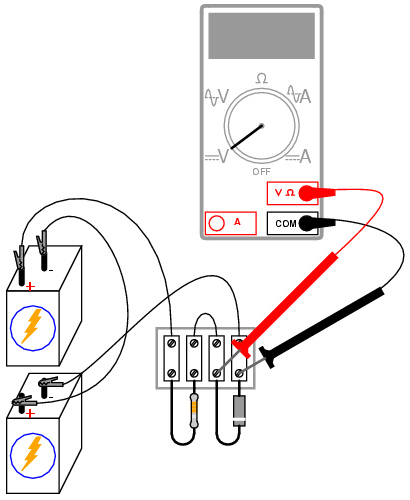Voltage regulator
PARTS AND MATERIALS
Any low-voltage zener diode is appropriate
for this experiment. The 1N4742 model listed here (zener
voltage = 12 volts) is but one suggestion. Whatever diode
model you choose, I highly recommend one with a zener
voltage rating greater than the voltage of a single
battery, for maximum learning experience. It is important
that you see how a zener diode functions when exposed to a
voltage less than its breakdown rating.
CROSS-REFERENCES
Lessons In Electric Circuits, Volume
3, chapter 3: "Diodes and Rectifiers"
LEARNING OBJECTIVES
SCHEMATIC DIAGRAM

ILLUSTRATION

INSTRUCTIONS
Build this simple circuit, being sure to
connect the diode in "reverse-bias" fashion (cathode
positive and anode negative), and measure the voltage across
the diode with one battery as a power source. Record this
voltage drop for future reference. Also, measure and record
the voltage drop across the 10 kΩ resistor.
Modify the circuit by connecting two 6-volt
batteries in series, for 12 volts total power source
voltage. Re-measure the diode's voltage drop, as well as the
resistor's voltage drop, with a voltmeter:

Connect three, then four 6-volt batteries
together in series, forming an 18 volt and 24 volt power
source, respectively. Measure and record the diode's and
resistor's voltage drops for each new power supply voltage.
What do you notice about the diode's voltage drop for these
four different source voltages? Do you see how the diode
voltage never exceeds a level of 12 volts? What do you
notice about the resistor's voltage drop for these four
different source voltage levels?
Zener diodes are frequently used as voltage
regulating devices, because they act to clamp the
voltage drop across themselves at a predetermined level.
Whatever excess voltage is supplied by the power source
becomes dropped across the series resistor. However, it is
important to note that a zener diode cannot make up
for a deficiency in source voltage. For instance, this
12-volt zener diode does not drop 12 volts when the power
source is only 6 volts strong. It is helpful to think of a
zener diode as a voltage limiter: establishing a
maximum voltage drop, but not a minimum voltage drop.
COMPUTER SIMULATION
Schematic with SPICE node numbers:

Netlist (make a text file containing the
following text, verbatim):
Zener diode
v1 1 0
r1 1 2 10k
d1 0 2 mod1
.model mod1 d bv=12
.dc v1 18 18 1
.print dc v(2,0)
.end
A zener diode may be simulated in SPICE with
a normal diode, the reverse breakdown parameter (bv=12)
set to the desired zener breakdown voltage.
|